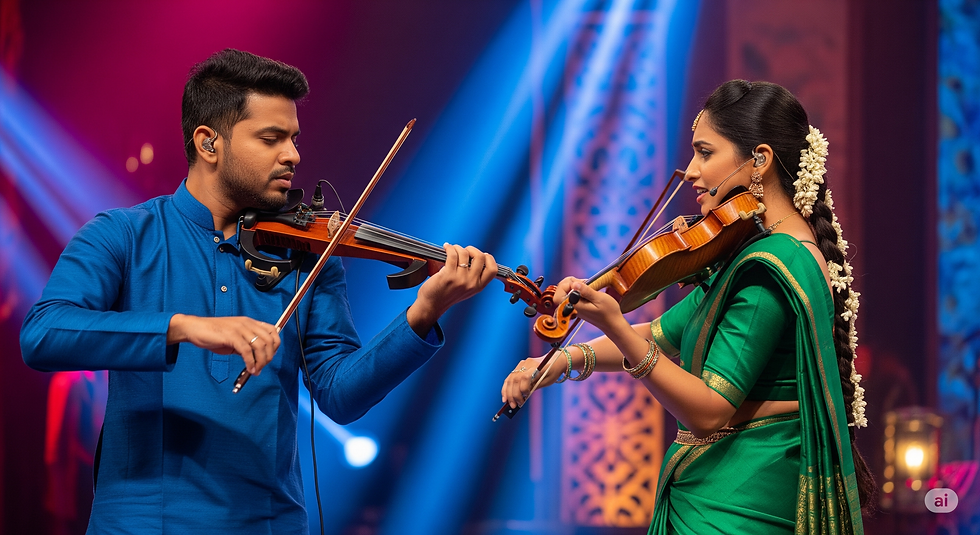"Hathaani: The Future of Tradition, One Violin String at a Time"
- Sharanya naidu
- May 20
- 3 min read
Updated: Jun 16
In the vibrant, evolving landscape of music, where tradition meets innovation, a fascinating development is taking shape: robotic musicians. One such marvel is "Hathaani," a robotic violinist designed to emulate the intricate and nuanced world of Carnatic music. This isn't just about playing notes; it's about capturing the very soul of a complex art form.

The Challenge of Carnatic Nuances
Carnatic music, the classical music of South India, is renowned for its rich melodic frameworks (ragas) and rhythmic structures (talas). What truly distinguishes it, however, are its gamakas – the intricate ornamentations, glides, and oscillations that breathe life into each note. Unlike Western classical music, where notes are often fixed, Carnatic music thrives on the fluidity and microtonal variations that gamakas provide.
For a human violinist, mastering these nuances takes years of dedicated practice under a guru. The subtle bends, slides, and vocal-like inflections require immense control over bowing, fingering, and an intuitive understanding of the raga's emotional essence. The question then arises: can a machine truly replicate this artistry?
Enter Hathaani: A Symphony of Code and Strings
Hathaani represents a groundbreaking endeavor to bridge the gap between human artistry and robotic precision. Developed by researchers like Raghavasimhan Sankaranarayanan, the goal is not merely to play pre-programmed tunes but to understand and reproduce the complex melodic contours and expressive qualities inherent in Carnatic music.
How does a robot achieve this?
Precision in Gamakas: Hathaani's design focuses on highly articulate robotic fingers and a finely controlled bowing mechanism. This allows it to execute the delicate oscillations, glides (jarus), and emphasis on specific notes that define gamakas. The challenge lies in translating the qualitative descriptions of gamakas into quantifiable movements.
Microtonal Accuracy: Carnatic music often employs microtones (śrutis) that fall between the semitones of the Western scale. Hathaani must be programmed to accurately identify and reproduce these subtle pitch variations, which are crucial for the authenticity of a raga.
Emulating Vocal Style (Gayaki): A hallmark of excellent Carnatic instrumentalists is their ability to emulate the human voice, known as gayaki. This involves playing phrases with the fluidity, breath-like quality, and emotional depth of a vocalist. Hathaani's development likely involves sophisticated algorithms that analyze vocal performances and translate those characteristics into violin movements.
Real-time Adaptation: True Carnatic performance involves a significant amount of improvisation (manodharma). While Hathaani might start with programmed compositions, the long-term vision would involve the robot's ability to interpret and respond to a human accompanist or even generate its own improvisations within the raga framework.
The Implications for Music and Technology
The development of Hathaani is more than just a technological feat; it has significant implications for:
Music Preservation: Robotic musicians could potentially help preserve and document the intricate playing styles of legendary Carnatic artists, ensuring that these nuances are not lost to time.
Pedagogy and Learning: Imagine a robotic guru that can precisely demonstrate complex gamakas or tirelessly drill a student on challenging passages. Hathaani could become a valuable tool for music education.
Cross-cultural Exploration: By demonstrating a machine's ability to grasp and perform such a distinct musical tradition, Hathaani opens doors for further exploration of diverse musical systems through robotic technology.
Defining Artistry: Hathaani forces us to ponder the very definition of musical artistry. While precision and technical mastery can be programmed, can a robot truly possess rasa (aesthetic emotion) or bhava (expression)? The journey of Hathaani will undoubtedly spark fascinating philosophical debates about creativity and consciousness in AI.
Looking Ahead
Hathaani's journey to mastering the Carnatic violin is an exciting testament to human ingenuity and the enduring appeal of music. As robotic capabilities advance, we may witness a future where machines not only perform complex musical pieces but also contribute to the evolution of musical traditions, pushing the boundaries of what's possible in the world of sound. The robotic violinist is not just an engineer's dream; it's a new chapter in the endless story of music.



Comments